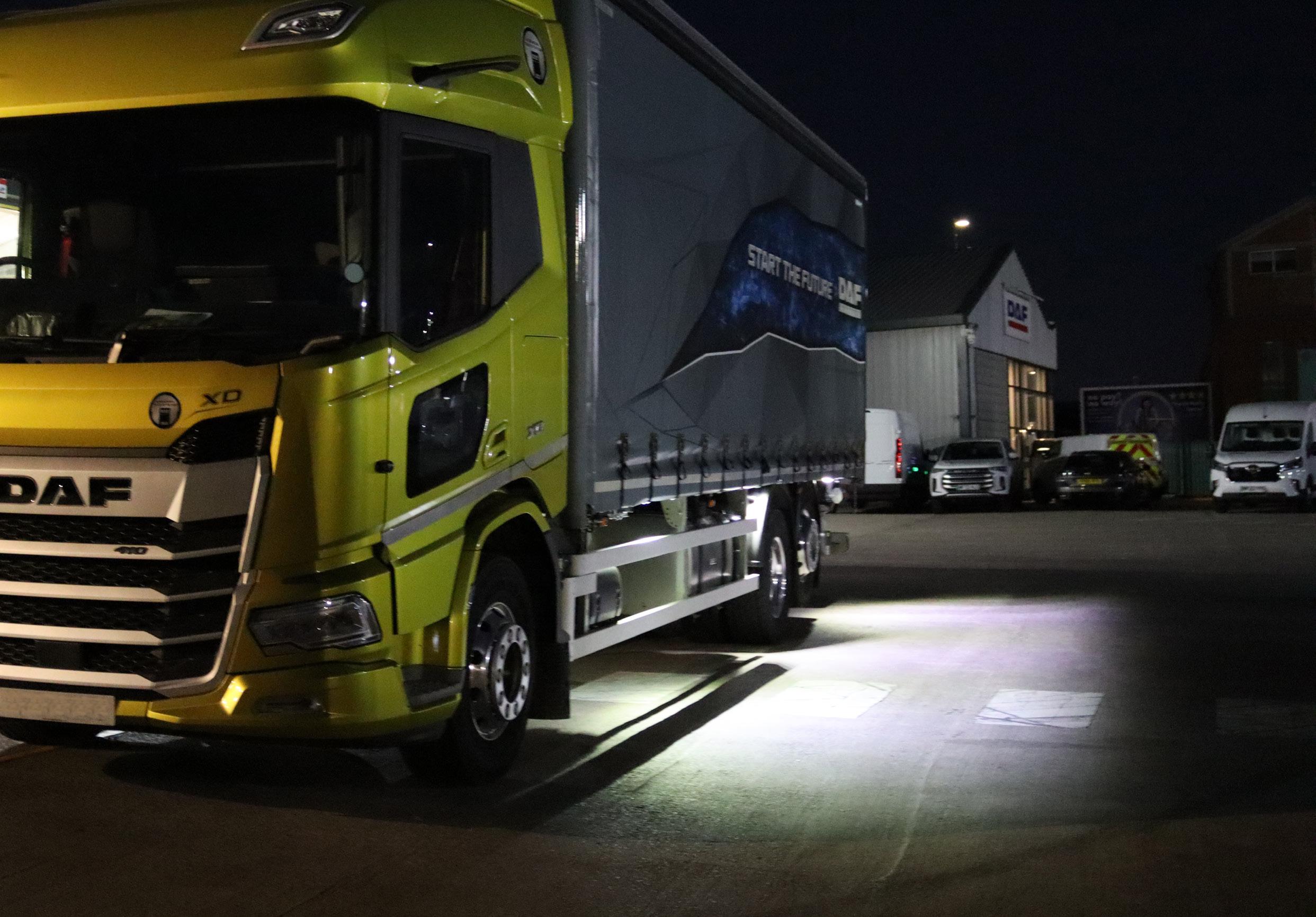














We promise to be by your side every step of the way. From initial operations analysis and planning, through to implementation and long term ongoing operation; ensuring you have a charging solution that can scale as your fleet grows. It’s another way that our alternate powertrains are driving the shift towards a sustainable transport system.


Welcome to the latest issue of Destination Net Zero magazine, and if you are reading this at the Commercial Vehicle Show, welcome too to our own dedicated ‘show within a show’, new for 2024: the immersive Destination Net Zero Zone.
We are delighted to be able to showcase the latest in low and no emissions vehicles and equipment, together in the same place, for the first time.
Truck manufacturers taking part include Mercedes-Benz, Renault Trucks, Electra, Iveco and Isuzu, displaying a wealth of technology from HVO-compatible diesel engines to fullon battery-electric heavy trucks.
Equipment on show includes ‘intelligent’ temperature-controlled trailers that eschew the use of diesel engines in favour of generator-axles to harvest kinetic energy to power their refrigeration units, and others that run the fridge as a ‘parasite’ from the truck’s main engine. See what’s on offer from Hulsteins, Schmitz Cargobull, and SDC Trailers.
The high capital cost of some of this equipment is an obvious hurdle to adaptation in a commercial environment, but there are various inventive solutions on offer that will enable operators to take their first step on the road to net zero without breaking the bank. You can find out more from Prohire and Zenith.
While the Destination Net Zero Zone concentrates on heavy vehicles and trailers, there’s plenty in the way of relevant exhibits in the rest of the show, too.
It’s almost impossible to introduce electric vehicles to a commercial operation without first establishing the routes and work cycles of existing trucks or vans, and then adjusting them to suit the constraints and opportunities offered by the switch to zero emissions power. There are plenty of telematics companies exhibiting who will be only too happy to help you to do this
When converting a transport operation to zero emissions technology, the easiest gains are usually made by changing the lightest vehicles over first. Again, the show is crammed with offerings from exhibitors in the van market
ranging from the giants like Ford and Harris Maxus to niche-market newcomers.
As you can read on page 16, the established van manufacturers face a formidable task in doubling the percentage of electric vans that they sell by the end of the year. This means that there will probably never be a better time to order an electric van than today, and there’s certainly a lot of choice on offer at the NEC.
If you’ve been on almost any management course, you’ll probably have been taken through a SWOT analysis. It stands for Strengths, Weaknesses, Opportunities and Threats. It’s apparent that the need to decarbonise will be a threat to many established transport concerns, but it also provides those prepared to think ahead with an opportunity to future-proof their activities.
With so many of the major players in the sector grouped here together in the NEC, there will be no better opportunity for you to start to set out on your own path to net zero.
Matthew Eisenegger, Publisher



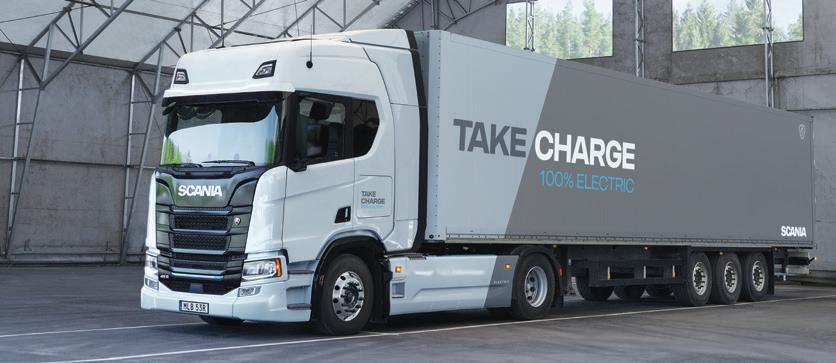





With extended cabs streamlined for energy efficiency, the Volvo Aero range is another leg on our journey towards zero emissions. Trucks designed to take you further and to make a difference to your bottom line. The Volvo Aero range is available with electric, gas or diesel powertrains and loaded with innovative features to maximise performance. Your efficiency. Extended.
Contact your local Volvo Trucks dealer or visit volvotrucks.co.uk
Volvo Trucks. Driving Progress

Electric vans from established manufacturers and innovators were highlights of the Commercial Vehicle Show preview day, where exhibitors such as Aquarius IT. Backhouse Jones, Chevin Fleet Solutions, Intelligent Energy, Mediafleet, Motormax and Ring Automotive highlighted their offerings.
Renault was discussing its plan to display the electric version of the all-new Master (below) with a promised 255-mile range along with the latest electric versions of Trafic and Kangoo. Powered by a 105kW motor generating 300Nm of torque, the electric Master comes with an 87kWh battery.
A 130kW DC fast-charger can add over 140 miles of range in 30 minutes says the manufacturer. A 22kW AC home charger can top up the battery from 10% to 100% of its capacity in just under four hours, it adds.
Renault will be taking orders for Master – the range includes diesel models too - during the second quarter of the year, with the first deliveries to customers scheduled for July onwards. With the future in mind it is worth noting that the newcomer has been designed to accommodate a hydrogen fuel cell.
Industry newcomer B-ON will be showing the electric Pelkan van. With a claimed payload capability of up to 1320kg and a range of up
to 185 miles, it is designed to handle last-mile parcel deliveries in urban areas.
With this duty cycle in mind, it can be specified with a parcel dispensing system which employs rotating shelves and scanners. It can automatically retrieve a package the minute the driver arrives at its destination says B-ON, offering a valuable time saving.
The time saved means that the system can pay for itself within six months B-ON estimates because it makes drivers more productive.
Pelkan (right) should be in service with European operators during the second quarter of this year says B-ON with the UK to follow thereafter, although a UK on-sale date has yet to be announced. It is being produced with a choice of battery packs - 43kWh or 54kWh – and will be available for test drives at the show.
ARB UK/Truckman is best-known for its Truckman range of pick-up load area hard-
tops. It is starting to make forays into the van market however with its aluminium BASE Rack roof rack and a modular drawer system for load areas.
It has become an authorised supplier of REDARC Electronics products. They embrace the Manager30 which can be used to charge and maintain onboard auxiliary batteries which tradespeople can then use to power tools.
Other products in its line-up include a suspension upgrade kit which can be used to help boost light commercial gross weights and a new drawer system for pick-up cargo beds.
Recently the subject of a management buyout, Locks 4 Vans is finding that there is a lot more interest in what it refers to as its statement locks. They are locks that have a clear presence on a van door’s exterior and act as a visual deterrent to thieves as well as preventing them from breaking into the vehicle.
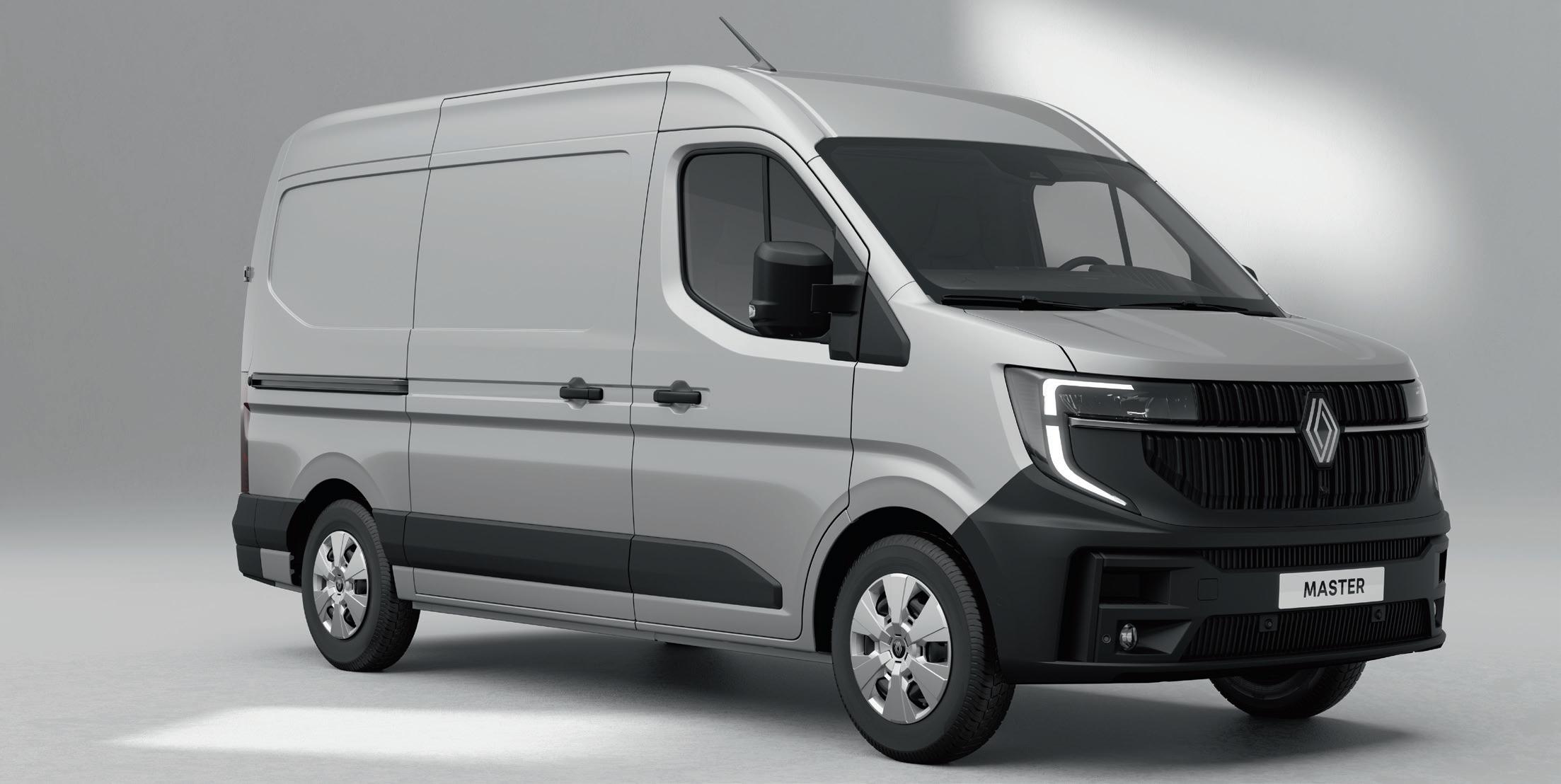


It is busy promoting a separate alarm for pickup hard-tops which are not always wired into the rest of the truck as well as slam-locks for the roller-shutter doors often found on homedelivery vehicles.
More and more firms are asking for rear window guards, says the company. Several vans have come onto the market of late with glazed hatch-type rear doors; and glazing can be smashed.
Fit a guard and a thief won’t be able to reach into the load area even if he manages to shatter the window.
Van load area racking storage system specialists were out in force at the media preview.
System Edstrom was talking about its bigcapacity drawers which can hold over 100kg of kit and can be slid out all the way out from underneath a van’s cargo bed.
The rising use of electric vans means that cargo bed floors that can be installed without the need for drilling – and potentially drilling into a high-voltage cable - are more important than ever before. System Edstrom offers this
type of flooring and racking can be attached to it as well as to handy fixing points already fitted to the vehicle.
The business is helping operators save weight and thus improve carrying capacity and reduce fuel consumption by making extensive use of high-tensile steel in its products. It is also helping them with their payload management – why is an engineer carrying three big, heavy, hammers when only one will ever be required for the job he or she is tackling?
Modul-System says that it is introducing its own range of roof racks and pipe carriers. It has also come up with what it describes as smart brackets which can be fitted to load area floors installed by van manufacturers to which racking can be secured, and has redesigned its cab jump-seat.
Parcels delivery companies may decide to remove factory-fitted single- and dualpassenger seats in order to save weight, and have a lighter fold-down jump-seat mounted on the bulkhead instead so that the occasional passenger can still be carried.
The company is rolling out an asset tracking system so that if a tradesperson has loaned
a colleague a tool, it will still be possible to locate the item in the colleague’s van; and retrieve it if it isn’t returned. The system enables geofencing, so if a valuable tool is left at a site, the tradesperson will be alerted as he or she drives a way; and can go back and fetch it.
Bott says it will have a major stand at the show, in a prime position opposite Ford. It will have a zero-emission theme, with electric models from VW, Vauxhall and specialist manufacturer Goupil on display and racked out.
Bott is busy developing a network of load area storage system fitting partners with seven now in place, including locations in Cardiff and London.
Turning to cameras and telematics, Trakm8 will be unveiling the RH800, an onboard mobile digital video recorder with builtin telematics. Elsewhere, after recently announcing a partnership with wheel alignment and balancing technology manufacturer Hunter Engineering, workshop equipment supplier Totalkare will be carrying out live demonstrations of its heavy-duty wheel-alignment kit.


“From a compliance point of view, I love it.”
“I have full visibility of everything that happens with our truck fleet. Already I’m using it far more than even I thought I would.”
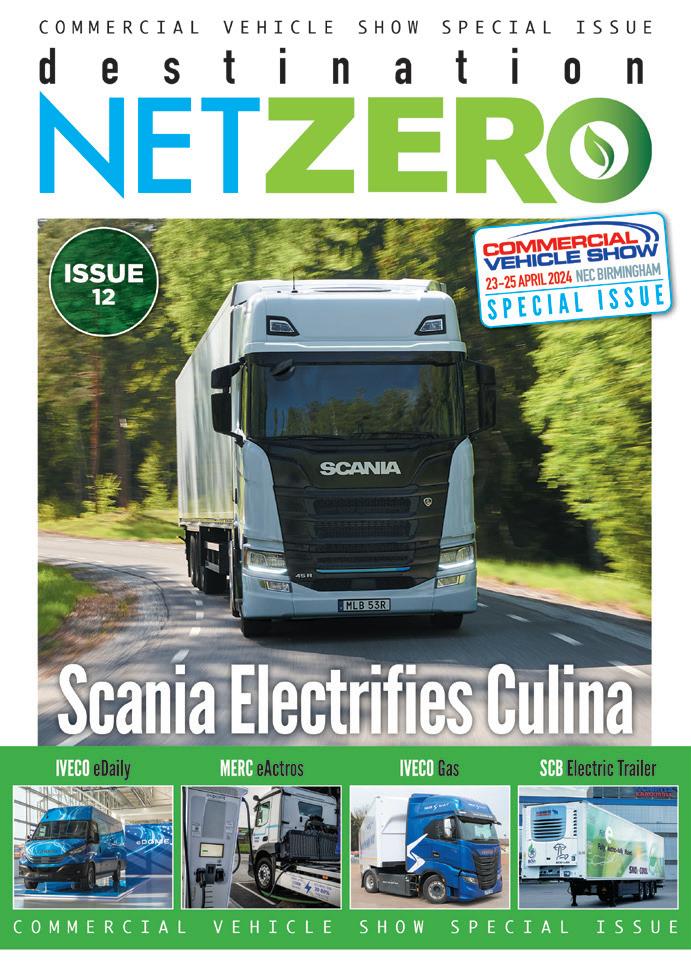
Compliance. Done digitally.

Close Brothers Asset Finance surveys small and medium-sized business owners – including those in the Transport sector - three times a year, asking them a variety of questions on a range of subjects.
This is what they had to say on what they were doing about their carbon footprint…
Q: Do you currently track your business’s carbon footprint?
Of the sectors surveyed, Transport businesses were the most likely to track their carbon footprint, with 56% of respondents saying they had measures in place; the UK average is 45%.
Q: As a business, which of the following measures, if any, have you taken in the past 12 months that have lowered your carbon footprint?
When asked what they had done to lower their carbon footprint, business owners said their top five measures were:
1. Investing in charge points
2. Installing solar panels
3. Changing energy supplier
4. Installing heat pumps
5. Improving insulation

For
Q: Of the following options, which one is your current business priority?
For this question, we asked firms to choose between two options or a combination of both – and the results were split fairly evenly between the three:
• Lowering our business costs, including utilities – 26%
• Reducing our carbon footprint – 31%
• A combination of both lowering costs and reducing our carbon footprint – 37%
• None of the above – 6%
Q: Would you consider taking out additional funding to pay to make your business more sustainable?
Interestingly, over half of firms (55%; UK average: 45%) are prepared to take out funding to make their businesses more sustainable; a third said they were not while the rest are ‘unsure’.
Very simply, it allows businesses of all sizes to get the equipment, vehicles and machinery they need. All without having to pay the full price upfront.
We understand the industries we work with and we offer a choice of finance options that best suit your needs. closeassetfinance.co.uk/dnz Contact us today




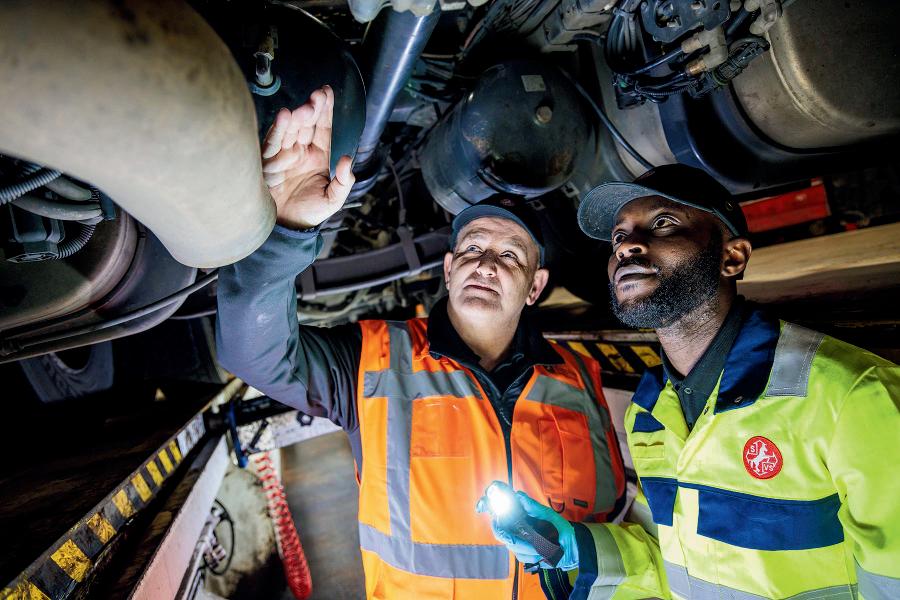

Sapphire Vehicle Services has been unveiled as the newest retrofit partner for Aerodyne, a leading provider of innovative aerodynamic solutions. In the pursuit of a greener future, fleet operators are increasingly turning to enhanced aerodynamics to reduce carbon emissions and enhance operational efficiency. Aerodyne’s solutions offer fleet operators the opportunity to achieve significant fuel and carbon efficiency improvements, with potential savings ranging from 3 to 10%.
Sapphire Vehicle Services is well positioned in the market to support operators and respond to increasing demand to improving operational efficiencies. Sapphire Vehicle Services has 13 strategically located depots throughout the UK & Ireland and has the facilities to retrofit such equipment on site.
One of the key challenges faced by fleet operators is the mismatch between existing aerodynamic designs and the diverse range of trailers used. While original equipment manufacturer (OEM) factory aerodynamics
are typically optimised for trailers with a height of 4.0 meters, trailers in the UK often vary in height, reaching up to 5.0 meters. This discrepancy results in increased drag and fuel consumption. Aerodyne addresses this issue by offering bespoke aerodynamic solutions tailored to different trailer heights, including the innovative autoadjust AEROMATIC systems. Additionally, installations of trailer aerodynamics can provide significant savings while solutions have been designed to mitigate the impact of operational damage.
These solutions not only offer tangible benefits in terms of carbon reduction and return on investment but also present a unique opportunity for fleet operators to embrace sustainability while also cutting costs. With demonstrable carbon savings and a rapid ROI achievable within as little as 12 months, projects are proving to be a ‘no brainer’ and one of the vital elements in building towards net zero.

While many fleet operators are incorporating Aerodyne’s solutions at the point of vehicle build, the partnership with Sapphire marks a significant milestone in extending these benefits to existing fleet vehicles. Together, we are embarking on a nationwide retrofitting initiative aimed at through a network of 13 Vehicle Maintenance Units (VMUs) strategically located across the UK. Sapphire’s expertise ensures seamless project management, minimising disruptions to daily operations, and maximising the impact of retrofitting efforts.
By joining forces, Aerodyne and Sapphire are not only championing sustainability but also revolutionising the impact of optimising aerodynamics considered as ‘low hanging fruit’ in the net zero journey. Together, we are paving the way towards a more eco-friendly and efficient future for the transportation industry.
Iveco has become known for its successful CNG and LNG trucks, but electric versions of the Daily van have struggled to gain acceptance. With a zero-emissions revolution underway in light commercial vehicles, is the moment is right for a brand new eDaily?
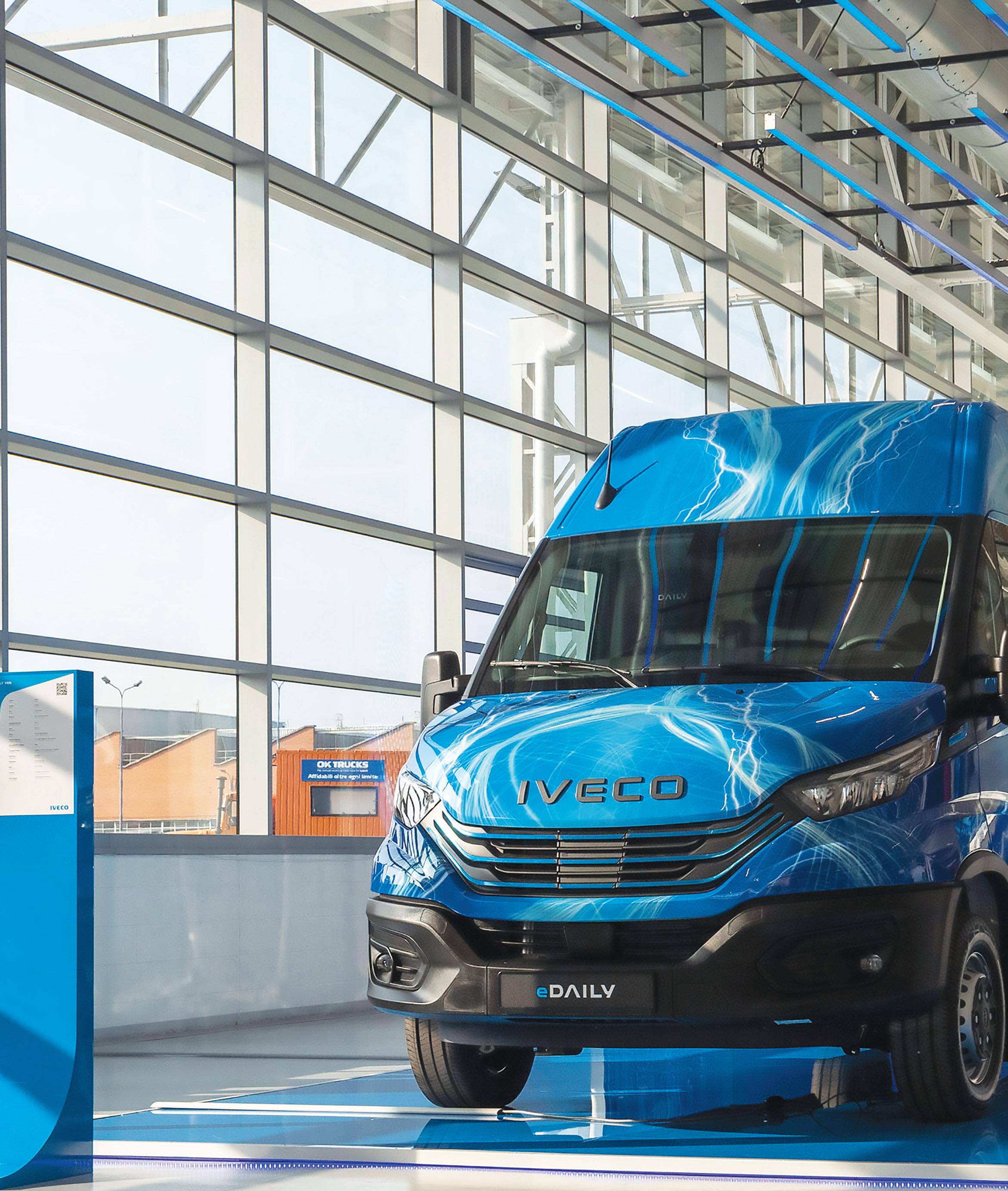
In terms of appearance little has changed from the diesel van, the exception being that the location of the charging points in the front grille, but there is a new redesigned Iveco badge for the eDaily with an E that mimics the appearance of an electric plug.
The real changes are in the chemistry of the lithium-ion phosphate batteries that are also bigger than previous eDaily’s and matched to a much more powerful motor. There are also driving modes, and a power boost function. It’s a significant step forward and the range covers a large variety of gross vehicle weights and vehicle types.
Panel vans have a load volume of up to 20m3 and there are additionally crew-cab, chassis-cab, and minibus body variants as well as single-wheel and twinwheel versions. In what Iveco promises is the most complete range of any large electric van currently on the market, the Iveco eDaily gets a full range of height and wheelbase options. Payloads are up to 4.6-tonnes, and it gets a 3.5-tonne

“Fast charging of up to 80kW is possible which is enough to add up to 62 miles (100km) of range in 30 minutes.”
towing capability. On top of that, there are also alternative rear axle ratios on the 50C and 72C versions – something no other manufacturer is offering – and the Air-Pro pneumatic suspension that was introduced this year on diesel variants is also an option.
A 140kW motor producing 400Nm of peak torque standard. There are, however, three battery options which are supplied in 37kWh modules: but if you specify just one battery, peak motor output is reduced to 100kW and 300Nm. Regular 3.5-tonne vans get the option of one or two batteries with either 37kWh or 74kWh batteries. The heavier 4.25-tonne GVW vans have the option of a third battery pack and therefore have 37kWh, 74kWh or 111kWh capacity. The very biggest 5.2-tonne and 7.2-tonne variants only get the two or three battery module options.


Each time you add a battery you’re adding more weight to the eDaily so there’s no hard and fast rule about how far each 37kWh battery module will take you. The 3.5-tonne Iveco eDaily with a single battery has a claimed range of 120km (75 miles) while adding a second doesn’t quite double the range to 235km (146 miles).
At the other end of the scale, the 7.2-tonne van has a range of 120km (75 miles) for the two-battery option and 180km (112 miles) for the three-battery van.
Fast charging of up to 80kW is possible which is enough to add up to 62 miles (100km) of range in 30 minutes. Iveco has also introduced a connected system allowing the remote control of charging operations and pre-conditioning of the vehicle temperature when connected to the charging socket. There’s a range of ePTOs of up to 15kW - enough to power fridge units, cranes or other items.
The eDaily gets three different driving modes and three levels of regenerative braking. To change driving modes you use a rocker switch to the side of the gear lever to choose between Eco, Natural and Power settings. Eco prioritises range saving by giving you 80% of the continuous power available and prevents you entering the Hi-Power mode. Natural gives you the normal amount of power, all 90kW of the motor’s continuous power, but limits how keenly it wants to engage the Hi-Power function. It pauses at full power before boosting into the extra capacity to give you 140kW. The Power setting allows the motor to seamlessly accelerate, calling upon all


140kW and 400Nm of torque for up to the two minutes of maximum peak power. It’s a good system that works well at maintaining range and providing the right amount of power.
Regenerative braking is controlled using the gear shift selector and simply requires you to push the lever to the side where there are three modes - Sailing, Standard Regenerative and One-Pedal Drive. Sailing is like any standard coasting mode in an electric vehicle and nearly stops regenerative braking completely. Standard mode is designed to mimic the engine braking of a diesel engine, so there’s a good deal of braking and energy recovery. One Pedal Drive mode is where regenerative braking is increased to the maximum. With a bit of forward planning, you can simply take your foot off the accelerator and have the electric van slow without the need to touch the brake pedal. It’s an effective system and combined with the three driving modes gives you a good amount of flexibility and personalisation to suit your driving style.
On the inside, the eDaily is much like the standard diesel van but there are a few differences. The information cluster has changed to give you much more data about the electric driveline including range and the various modes of the electric van. It’s quite a lot to take in, and the console is a bit too cluttered for the uninitiated, but once

accustomed to it you can clearly see which mode you are in for the regenerative braking and there’s simple PWR or ECO lettering for when you change the driving mode.

Like the diesel van, the eDaily gets the Iveco Driver Pal – Iveco’s version of an Amazon Alexa – that is mounted below the rear-view mirror. There’s a touchscreen capable of smartphone mirroring with Apple CarPlay and Android Auto which also gives you uptime management features and energy consumption data as well as navigation and range forecasting.
The cabin itself is large and spacious with excellent visibility all around. The seats are comfortable and because of Iveco’s heavy truck background there’s always the option of an air-suspended driver’s seat which improves the already decent ride comfort.
It finally seems like Iveco has the right product on the market at the right time, with the eDaily a genuine rival to the Ford E-Transit but with the added benefit of higher GVW variants. Charging capabilities could do with being faster as even 80kW will still mean a considerable wait for the largest battery size, but the eDaily could be a dark horse for van operators wanting to go electric.



• Large and spacious cab with excellent visibility all around

Electric vehicles make up just 5.2 per cent of the total of new LCV registrations for the first quarter of 2024 according to the latest SMMT figures.
This is just over 50 per cent of what will be required each quarter to meet the ZEV Mandate for the year, so our industry has a long way to go, and a long educational journey to perform, if the target of 10 per cent is to be met.
Operators who have made the transition to EV in recent years have been mainly from the large fleet sector, and many have now reached a plateau for many reasons, such as infrastructure capability at their locations, or vehicle-specific applications.
There is no doubt that the electric vehicle choice for buyers has never been better nor more varied, so it’s certainly not a restriction in available product. Vehicle ranges are now,
depending on van size, hitting 200 miles or very close to it, and we hear weekly from the charging providers that more and more points are opening all across the country. So what are the barriers still in the way of mass adoption?
Recently, I undertook with DNZ, a 734kms (456 miles) roadtest in a new Renault Trucks Trafic E-Tech L2H1 panel van which is a very typical one-tonne van in UK and Ireland – it is the size of van that is the staple of the SME community. While 734 kms over two days is not typical of the SME community usage, we wanted to push the envelope of what might be achieved. The van worked brilliantly: easy to use and quiet, and whilst loaded driving on a wide mix of roads including over 65%
motorway, achieved a range of 160 – 180 miles on a charge. What we did find however were faults in the thing we were unable to control, namely the UK’s public charge point infrastructure, and it was this, and only this, that could have potentially derailed the experience.
So, what did we find despite some planning ahead?
Well public charge points are typically lacking in fiscal signage i.e. you might get info on your app but stand next to one and you are unaware of what you are able to pay, fixed tethered leads on chargers are not long enough for reach commercial vehicle charging sockets, the bays are designed for cars only and are simply not fit for safe use
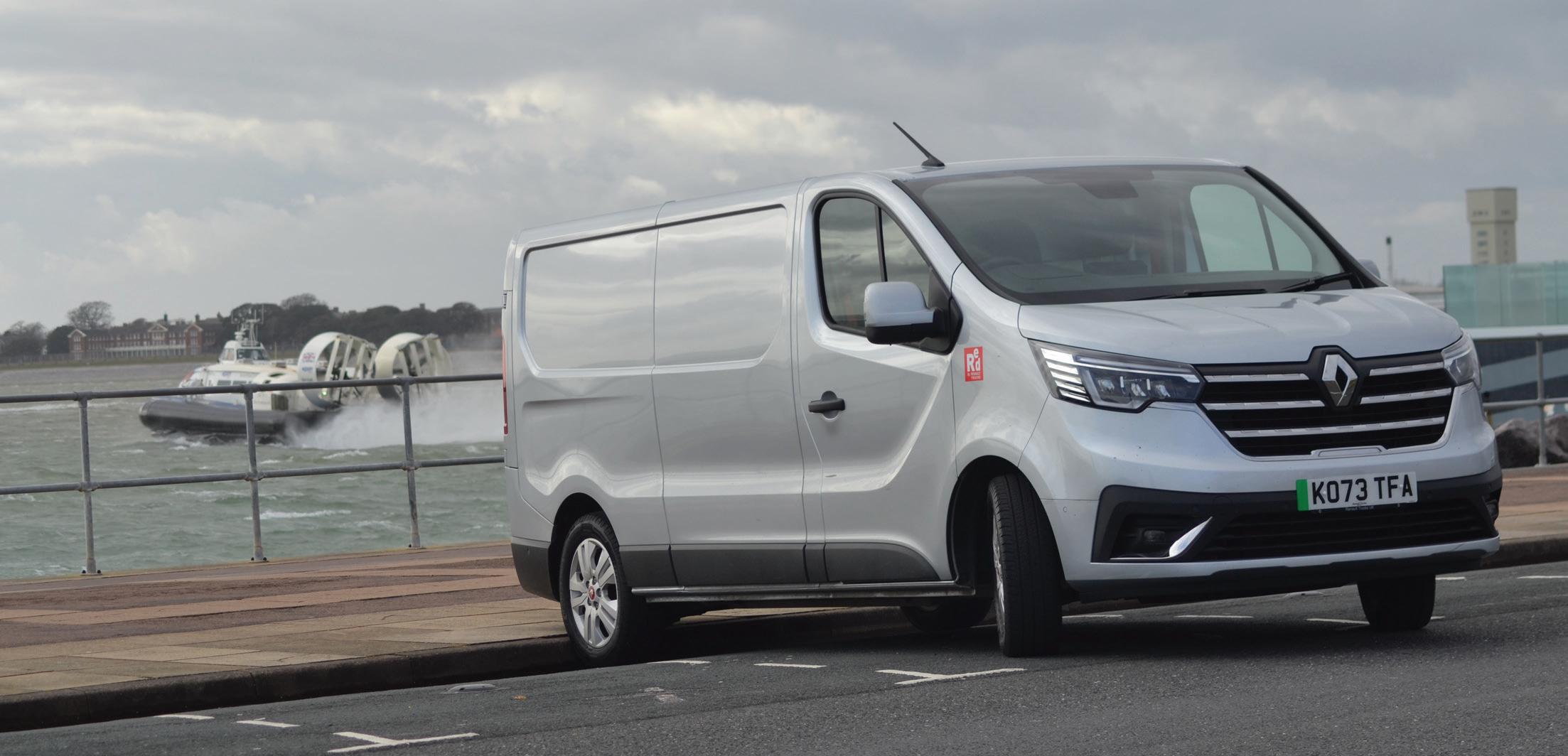
“In summary the key is about choosing the right operations within your own organisation to move into EV operation.”
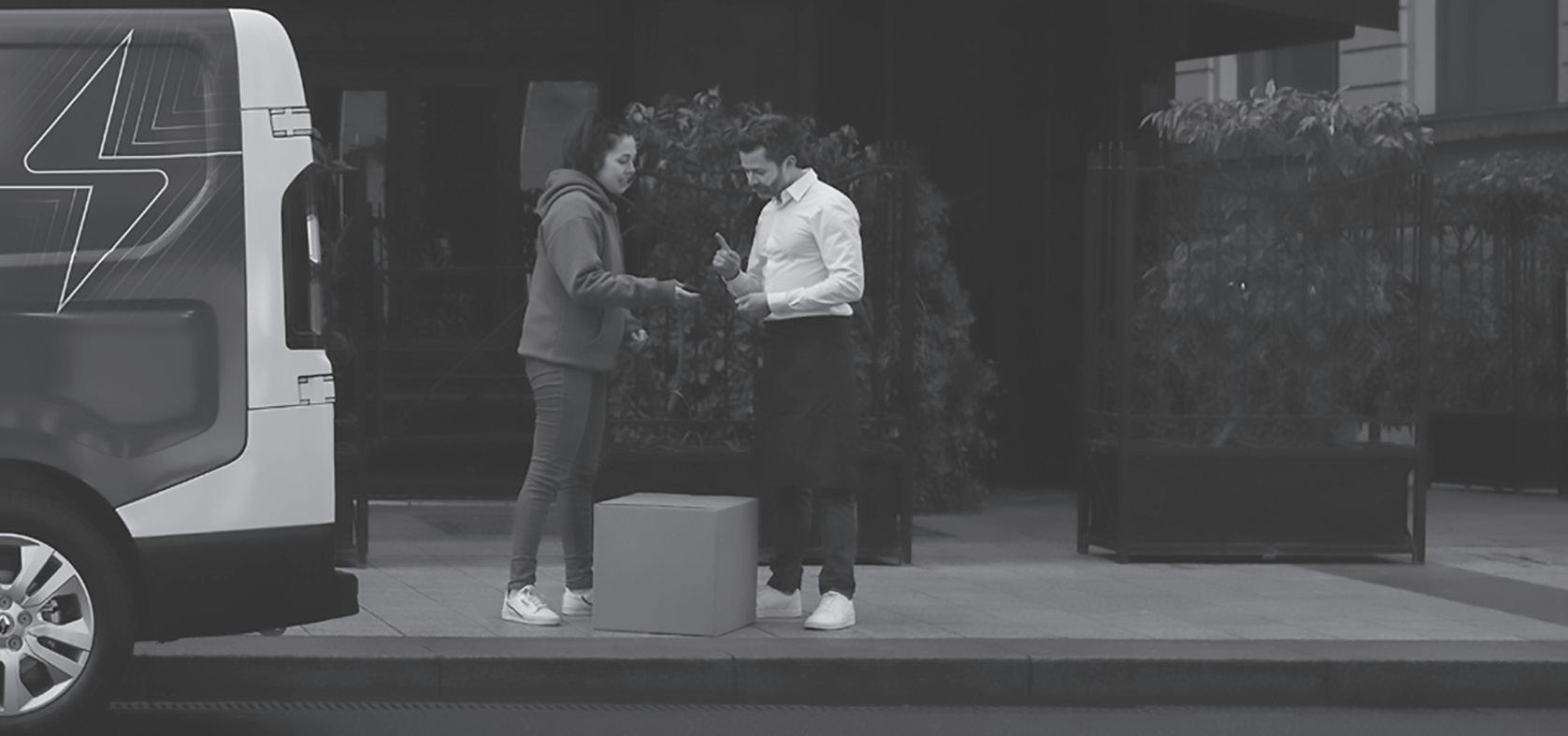
by a commercial vehicle, and from a pricing perspective, the public arena is like the wild west with hidden charges like £10 for going over 90 minutes stay as an example, and finally you can arrive at a charger that you have been led to believe to be working only to find that it is out of order.
It seems that landowners, whether that be supermarkets, garages or independent locations, feel they have ticked the EV box by offering a charger and two bays, however beyond this they have almost zero interest in the users of these facilities.
Turning a negative into a positive is easy to do with regards to the test because the vehicle worked brilliantly but what it has shown is that suitability for purpose and the correct choice of vehicle is absolutely key in having a great, workable experience.
So, let’s remember what the Trafic E-Tech’s intended market is: it’s the SME community in the main, the tradespeople and shop owners, plus public sector councils and housing associations, and local logistics companies. These are all ‘back to base’ operators and so will probably never need to use the public network to charge as all their journeys are local or of a reasonably short distance. Hence traveling 700+ kms over two days is highly unlikely but, as we demonstrated, still achievable.
The beauty of vans like the Renault Trucks Trafic E-Tech is that once you have your AC charger fitted at your premises you really and truthfully need not worry a single jot about how good or poor the public charging infrastructure is, because you will always have a full charge in the morning and as a result stress free motoring not to mention a happy financial director due to the huge variance in cost between a typical £0.79/kW public charge cost versus some of the home off peak tariffs which are as low as £0.10/kW.

• Grahame Neagus

This fiscal argument means that for the SME and local fleet community, the transition to EV vans like the Trafic E-Tech a no brainer, if home or depot can have a charger fitted. Add solar panels to your location, store the energy and then use that and you truly have free fuel: you can’t get much better than that.
In summary the key is about choosing the right operations within your own organisation to move into EV operation. Ask yourself, how many LCVs really do more than 180 miles a day? In reality, very few and so its beholden upon us in the industry to educate the builders, plumbers, carpenters and other SMEs within the UK and Ireland as to just how effective running
an electric LCV can be, especially when you are in control of your own fuel supply back at base.
Peace of mind is what we all seek, so how rewarding is it to now be in control of not only your operation but also in your fuel supply and be able to have zero fear over the current issues surrounding public charging even if it is getting better by the year?
The choice is yours, but suitable vehicles are both highly efficient and effective, so match these with your own power supply and you are the master of your own destiny whilst making a positive impact on the environment and your own profitability.
Culina and Co charged up by placing huge Scania order
Scania UK has completed a deal with Consortium Purchasing group to deliver 100 battery-electric trucks over the next 12 months.
In a pivotal moment for the industry, those BEV 4x2 tractor units will be split across Consortium’s members: Culina Group, WS Group, A.W. Jenkinson Group and its subsidiaries, becoming among the first Scania EV tractors to enter service in the UK.
In what has been coined as a one of Scania’s largest BEV orders to be fulfilled in one calendar year, Christian Levin, Chief Executive Officer for Scania AB, said this deal is a significant milestone in the two organisations’ history, and shows the intent to move towards more sustainable transport solutions, adding: “Scania has had a close and successful relationship with Culina Group, WS Group and A.W. Jenkinson Group for many years.”


These 100 battery electric trucks are Scania’s regional-haul 4x2 tractor units, officially launched in June 2022, with customers originally expected to start taking first deliveries in Q1 2024. They are powered by a triple electric machine powertrain, producing approximately 560hp, and are equipped with an electric power take-off system to support temperature controlled or bulk transportation.
They are also the first Scanias to come fitted with the Northvolt battery cells giving 468 kWh of usable capacity, which yields a range of up to 350km.


“These trucks are powered by a triple electric machine powertrain, producing approximately 560hp”





Christian says: “This vehicle represents a major milestone for us and for our partners. “We’ve increased our range and are offering new opportunities to cater for a wider selection of customers and the whole transport ecosystem. These trucks are part of the solution that the transport industry is asking for.”
Alongside these trucks, Consortium Purchasing is purchasing another 2,400 vehicles, including 2,250 diesel trucks powered by Scania’s latest generation and efficient 13-litre SUPER powertrain. The other 150 are earmarked to support the Consortium’s German and Dutch operations.
William Stobart, Deputy CEO of Culina Group, was delighted by the deal, stating the group of companies were pleased to renew their agreement and relationship with Scania.
“It’s been a difficult time for all the OEMs with global supply issues,” he adds. “But Scania has worked closely with us over the past two years to minimise the impact for both parties. This is testament to the true partnership between the businesses.”
Chris Newitt, Managing Director for Scania UK, concurred adding this was the perfect opportunity to cement the ongoing relationship between the two companies during a period of such transition.
“It’s testament to the strength between the two organisations that we can make this announcement,” Chris adds. “But also, to those involved in making it possible over the many years that this deal is built upon.”
This has been confirmed as one of Scanias largest European and battery-electric vehicle orders to be completed over one calendar year by Scania.
The vehicles will be delivered to the group in batches of at least 500 per quarter.


“It’s testament to the strength between the two organisations that we can make this announcement”
The weather is against it, so will the new Mercedes distribution truck flatter or just fall flat?.
Words: Adam Fairbrook
Mercedes-Benz’s expanding range of battery-electric trucks is intended to serve a multitude of sectors: eActros 600 is being readied to tackle extended journeys of up to 500 km per charge, while eEconic is aimed at lowmileage municipal workloads. Sitting in between the two are eActros 300, and eActros 400, which are for shorter-haul missions.
The eActros 300 LS has a claimed range of 135 miles (220 km) on a full charge. Its remit is regional distribution – such as multiple local trips between depots without travelling too far away from base.
To make things a bit more exciting for this test drive, the plan was for us to drive eActros along the motorway from Merc’s Wentworth Park HQ in Tankersley to the newly installed truck fast-charger at
Rivington Services. There, we’d top up the batteries during a short break before heading back. Totting it all up, we were looking at a round trip of about 160 miles.
Our cargo would be 12 tonnes of concrete – half the truck’s 24-tonne overall payload potential with a standard trailer – meaning we’d be grossing 28 tonnes overall.
Based on a 4000 mm 4x2 chassis, the eActros is slightly longer than a diesel equivalent because it needs some extra space for its three 112 kW/h battery packs (97 kW/h usable) –which combined totals 336 kW/h (291 kW/h usable) capacity.


Mercedes’ rear eAxle is powered by two motors producing 330 kW (equivalent to around 443 bhp) of continuous power and 400 kW (536 bhp) peak. The eAxle uses a two-speed automatic transmission with two forward and reverse gears. Also installed was the latest version of MirrorCam and Merc’s wide range of safety systems, including Active Brake Assist 5, Attention Assist, Lane Keeping Assist, Stability Control Assist, Traffic Sign Assist and Proximity Control Assist. To be honest, we were quite glad of these as the weather was awful – very strong winds and torrential rain were already in full swing when we climbed into the driver’s seat.
The air-suspended ClassicSpace 2.3 m wide M-Cab will be familiar to anyone who’s driven the diesel version. Inside is Merc’s 12.3-inch MultiMedia Cockpit with central dash-mounted infotainment screen, though this is augmented with a few extra screens detailing energy flow and battery charge level. At the start of our run, the truck was charged to 84% – plenty to get us to Rivington, despite the harsh headwind and driving rain.
One thing we always notice with electric trucks is how quiet they are in operation. There’s only a slight whine from the motors when pulling away. To say it’s peaceful is an understatement – the quiet cab makes for a very relaxing drive.

The eActros is also very comfortable. Its driving position feels spot-on and the truck responds very positively at junctions and roundabouts, largely thanks to an abundance of torque from the eAxle.
There are three driving modes: Power, Economy and Range. We selected Economy for our drive because of the weather conditions, which limits us to 53 mph. Power mode goes to 56 mph, while Range is limited to 51 mph to ensure maximum driving distance.


“Mercedes’ rear eAxle is powered by two motors producing 330 kW (equivalent to around 443 bhp) of continuous power and 400 kW (536 bhp) peak.”

Threading our way out of Merc’s HQ, we joined the M1 towards Leeds, engaged cruise control and settled back for a smooth ride. Before long we picked up the M62 to Manchester, which would carry us past Rivington southbound – so we’d need to spin around at the next junction and double back a few miles before we could make our stop.
The wind and driving rain battered us all the way and it proved a good real-world test for eActros. We didn’t shy away from pumping up the heating, air con and demisters either, putting further strain on the batteries – but regardless, the truck took it all in its stride.
eActros uses regenerative braking to reduce speed while descending hills and it works in a similar way to an engine brake. It has five stages, with stage three proving versatile for most things. However, stages four and five really dig in, which is good to know in case you have to react quickly to traffic conditions.
Regenerative braking puts energy back into the batteries, so it’s important to get into the habit of using it top up the cells whenever possible. The cruise control takes care of this automatically for the most part, and a quick look at the Energy Flow screen shows how much power is being restored to the batteries when the system is engaged. It’s surprising just how much energy can be recuperated on long downslope, and even multiple short bursts can add up to a good few extra miles.
Reaching our destination at Rivington Services (southbound), we pulled right up to the brand-new evpoint HGV charging station. Our outbound trip of 81.7 miles took 1 hour 42 minutes at an average speed of 48 mph, due in no small part to the adverse weather. Efficiency figures were 125.8 kWh/100 km, or 0.49 miles/kWh. Battery level at the start



of charging at Rivington was 30%, meaning we’d used 54% of the battery getting there.
Once hooked up, we gave the batteries a 57-minute top up which was enough to put 122 kWh back into the cells at a cost of £79.12. Using a public fast charger was never going to be cheap!
The battery level when we left was showing 68%.
The weather was equally bad on the way back, but the comfortable cab and easy drive meant we weren’t getting fatigued. A few miles from base, eActros automatically selected Range mode and dropped our top speed to 51 mph when the battery level reached 20%.
After battling through the storm, we made it back after a 158-mile total round trip with just 18% left in the batteries. Efficiency was 127.9 kWh/100 km and 0.49 miles/kWh at an average speed of 40 mph.
Overall, the eActros gave us a very pleasant drive despite the conditions. It’s encouraging to see HGV fast-chargers starting to be installed at motorway services, but there is of course a very long way to go before they can be seriously considered an option for most e-truck operators – not least because of the price. That said, this particular vehicle is intended for short regional distribution, which means charging at base would remain the obvious – and vastly cheaper – option.
Make & model:
Mercedes-Benz eActros 300 LS
GVM/GCM:
19,000 kg / 40,000 kg
Axles:
8.0-tonne steer, 11.5-tonne drive
Wheelbase:
4000 mm

Motors:
2 x motors integrated into eAxle
Batteries:
3 x 112 kWh installed (each 97 kWh useable)
Total capacity:
336 kWh installed (291 kWh useable)
Transmission:
Two-speed automatic (two forward, two reverse)
Power:
400 kW (peak), 330 kW (continuous)
Tyres:
315/70R22.5
Cab:
ClassicSpace 2.3 m wide M-Cab with 170 mm tunnel
Range:
Up to 220 km (135 miles)
Max Charging Rate:
160 kW
Charging time:
20-80% in 75 mins

“Efficiency figures were 125.8 kWh/100 km, or 0.49 miles/kWh. Battery level at the start of charging at Rivington was 30%, meaning we’d used 54% of the battery getting there.”
Iveco has CNG versions of its new S-Way models which are gaining popularity – but you need to make sure it’s right for your operation. Words: Pip Dunn
could well be the firm’s last diesel heavy truck, certainly for Western Europe as by the time it is due for replacement, diesel engines should be in the minority, and legislation will slowly kill them off. Accordingly, every manufacturer is looking at alternative fuels, be it gas, electric or hydrogen.
Electric trucks are improving, but are still in their infancy and currently too expensive, too heavy and have inadequate range.
One alternative fuel is gas – either Liquid Natural Gas (LNG) or Compressed Natural Gas (CNG). Iveco has been a big proponent of gas trucks and it has steadily improved its gas offerings.
Until relatively recently, the best it could do for the heavies was a 4x2 Stralis with a 400hp output, not really ideal for 44 tonnes. But four years ago, it unveiled its 460hp Stralis 6x2 with an LNG option, perfect for 44 tonnes.
On LNG, the range for a 4x2 went up to about 700 miles between fills, and the only issue with a 6x2 was the reduced fuel tanks, which limited the range compared with a 4x2 to about 450 miles. For CNG, only available as a 4x2 the range is about 400 miles.
The biggest issue with gas trucks is availability of fuel as the network for gas stations is still woefully inadequate and likely to be the biggest factor to put people off gas trucks. But it is slowly improving.
For the right type of operation, gas trucks are a viable alternative to diesel, but some firms are opting to set up their own filling capabilities and keep their gas trucks on a very tight rein.
I took a new S-Way 460NP 4x2 running on CNG - out for a day’s drive to see how it performed and to see if it can sway the mind of even the most ardent diesel-head.

From the outside there’s not a lot to tell you the truck runs on gas, apart from the NP badge. Look closer and you’ll notice the fuel tank is different. Instead of the more cylindrical diesel tank, the CNG relies on a number of smaller cylinders hidden behind a panel while makes the truck look like it has side skirts. On LNG trucks, there is one larger cylinder instead of the normal diesel tank.
Under high roof twin bunk sleeper cab, the same Cursor 13 12.9-litre straight six engine is used, it merely uses gas as opposed to diesel to power it. Ivecos’ gas engines are either the Cursor 9 8.7-litre in 340 and 400hp outputs or this, the bigger engine at 460hp.


However, in CNG form the 12.9-litre engine only develops 460hp and 2,000 Nm of torque, the same as the diesel Cursor 11 at the same output so there is a weight penalty to consider there. The overall weight – always very favourable on any Iveco – is still 7,875kg, which for a high roof 4x2 tractor is impressive.
The gearbox is Iveco’s Hi-Tronix 12-speed automated which is easy to use and performs very well. The cruise control is easy to use and effective, and like all Ivecos, the five-stage engine brake is superb and easy to use, and above all, effective.
Is there any difference in performance of a gas truck over a diesel? In fairness there isn’t. 460hp is more than adequate, but if you want more oompf, then that is not available. But the reality is 460hp is adequate for pretty much every operator at 40-44 tonnes so it should not be an issue. I had it loaded at close to 40 tonnes and I took it on a circular trip, including a visit to a gas station at Crick where I topped it up, not because the truck especially needed it, but to see the practice in operation.
I enjoyed a mix of motorway, dual carriageway and single carriageway roads and on the latter, there was plenty of twisting and turning on the ‘back roads’, and it performed admirably.
So, in terms of performance you really won’t notice much difference. It did seem a bit noisier, but the sound insulating inside the cab drowned that out. It did emit a bit of steam when it was fired up but that soon cleared and was never an issue.
Filling up is easy, but there are staff on standby at the filling stations to run you through the procedure and do it for you if you so desire. You have to be shown how to use the gas pumps safely and effectively but once trained, it’s simple.

“If you want a gas truck, then the Iveco is close to top of the pile”
As a truck, it really isn’t any different to a diesel. It’s the support that is the biggest factor in making the switch. Should you go gas? Well, like anything, especially something new, there are plenty of pros and plenty of cons.
The pros are its better for the environment, there are tax advantages and LEZ charge advantages. The fuel is – generally - cheaper to buy, and it works out about 10p a mile less to operate a gas truck, which saves you typically anything up to £10,000 a year.
The cons are the truck itself is more expensive to buy (or lease), and operators of CNG trucks say they are “typically about £30,000” more expensive compared with a diesel equivalent. With that in mind, you only start to make that money back on year three or four. So, you need to do you sums right. It needs to be used on the right operation as well – and double shifting can definitely a winner.
The biggest factor is the infrastructure, and this will probably be the driver in making the switch. If you have no gas stations near your yard, then it could be a nonstarter. But if you have one or two on your routes then its less of a hassle. If you have the ability to fuel at your yard, then it’s much easier.
And that is where gas trucks – currently – come into their own – on ‘repeat itinerary’ regular runs, on dedicated contracts where there is the scope to fill up regularly.
The biggest worry for any driver of a gas truck is running out of gas, and a closed gas stations can be a nightmare if you regularly use it, so it’s all about the planning.
Gas trucks might also be restricted. If you do have a gas fleet and a diesel fleet, and the former is tied in to a particular job, it might not be possible, or at least wise, to chuck a gas truck out on a diesel truck’s job.




•
As a truck the S-Way NP is nice to drive, the cab is excellent. It’s a stunning truck and lends itself to superb liveries.
Back up remains less extensive with Ivecos on the whole, but it doesn’t have too much competition on the gas market, especially in the tractor market, and the brand is typically cheaper.
The biggest factor will be simple – it is suitable for your operation or are you leaving yourself open to issues if you can’t get the gas? That needs to be the biggest concern and the driving factor, because as a product there’s not a lot to fault it on. You also need to think about how you acquire the vehicle. Given technology is moving fast – both in gas and other alternative fuels, leasing might be a better option as you’ll need it for at least four years, but at the end of that period, what else will be on the market? And more importantly will there be a market for secondhand gas trucks if they are in anyway obsolete, outdated or simply not a match for new products? Worth thinking about.
In short, as a gas truck the S-Way NP is a lovely truck to drive, it has appeal both in looks and its green credentials. The biggest factor is the infrastructure and the chance gas trucks could get overtaken in the technological advancements of other forms of propulsion, such as electric. That is unlikely to happen in the life of the truck were you to buy one tomorrow, but long term it might be an issue on the residuals.
If you want a gas truck, then the Iveco is close to top of the pile. But you need to know if it’s suitable for your operation. General UK tramping, then it probably isn’t. Ringfenced, repeat work on a set route and job, provided there is the gas fuelling infrastructure nearby, then it most definitely is.



Design GVW: 40 tonnes
Chassis: 3800mm wheelbase
Front axles: 7,500kg capacity. 315/70R22.5
Michelin XFA Energy tyres
Rear axle: single-reduction axle, 13,000kg. 1:3.7 ratio
Gearbox: 12TX 2010 TO 12-speed automatic
Engine: Cursor 13 12.9-litre straight six
Max power: 460hp @ 1,900rpm
Max torque: 2,000Nm @ 1,100-1,600rpm
Cab: AS high roof double sleeper










Here you’ll find the latest and greatest range of vehicles, equipment, green technology and innovation available for a sustainable future in commercial road transport.
VISITOR REGISTRATION FROM JANUARY at cvshow.com










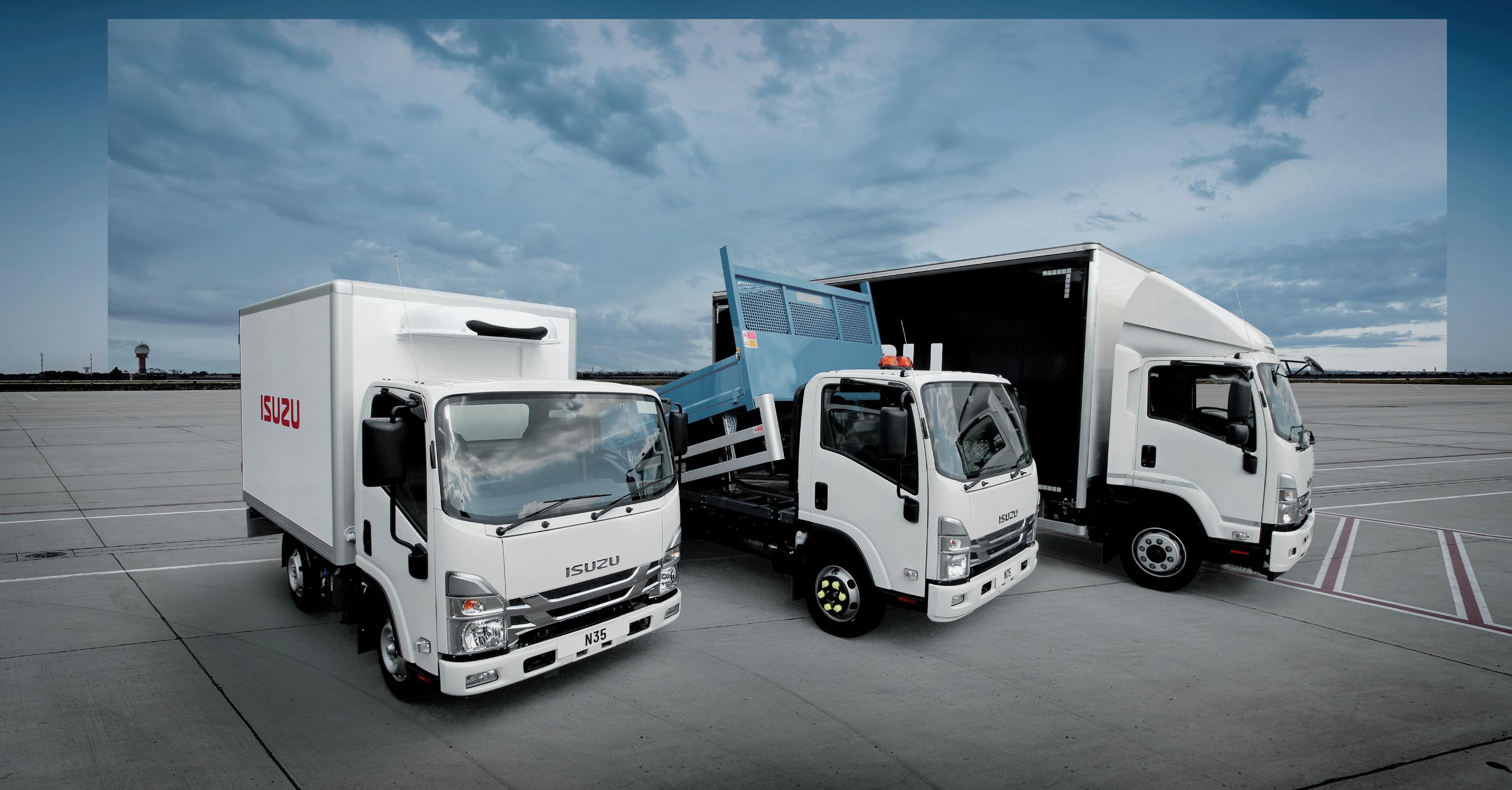
Schmitz Cargobull will have its all-electric box body semi-trailer – the S.KOe COOL – on display at the Destination Net Zero Zone at this year’s CV Show.
Europe’s leading trailer manufacturer has developed the reefer semitrailer with e-axle generator to help operators meet increasingly strict emissions regulations.
Officially launched in the UK & Ireland earlier this year, the S.KOe COOL is equipped with the fully electric S.CU ep85 cooling unit with integrated power electronics, a battery system and an electric generator axle, enabling 100 per cent emissions-free operation. The electrified semi-trailer is also extremely quiet, ideal for early-morning and late-evening deliveries in urban areas.
Colin Maher, Managing Director Schmitz Cargobull UK & Ireland, says: “The S.KOe COOL is the perfect choice for businesses who are leading the charge towards a cleaner and greener transport sector. We are delighted to be able to introduce the fully electric semitrailer across the UK & Ireland, providing our customers with a truly sustainable solution for their temperature-controlled operations.”
Already in operation with more than 50 customers across Europe, last year the S.KOe COOL achieved overall vehicle type approval by the German Federal Motor Transport Authority (Kraftfahrtbundesamt) after meeting all the relevant statutory safety, environmental and production requirements of the EU – making Schmitz Cargobull the first manufacturer to gain type approval for a fully-electric refrigerated semi-trailer with an e-axle.
The electrified Schmitz Cargobull trailer axle recuperates energy during braking, among
other processes, extending the cooling unit’s operating time or reducing the recharging time of the battery via the power grid.
Thanks to three pre-defined modes (ECO, STANDARD and SAFE), the semi-trailer can be optimised according to the customer’s usage conditions and objectives. The modes can be selected via the display and keypad on the transport cooling unit or via the Schmitz Cargobull TrailerConnect® telematics portal and app.
The generator performance of the electrified axle is precisely matched to the requirements of the cooling unit. It is fully integrated into the Schmitz Cargobull telematics set-up, enabling the respective system status such as the battery charge level, remaining range and charging time, to be monitored via the TrailerConnect® portal.




“The S.KOe COOL is the perfect choice for businesses who are leading the charge towards a cleaner and greener transport sector.”

